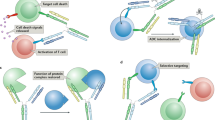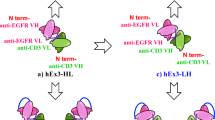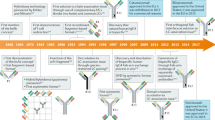Abstract
By enabling the simultaneous engagement of two distinct targets, bispecific antibodies broaden the potential utility of antibody-based therapies. However, bispecific-antibody design and production remain challenging, owing to the need to incorporate two distinct heavy and light chain pairs while maintaining natural nonimmunogenic antibody architecture. Here we present a bispecific-antibody production strategy that relies on co-culture of two bacterial strains, each expressing a half-antibody. Using this approach, we produce 28 unique bispecific antibodies. A bispecific antibody against the receptor tyrosine kinases MET and EGFR binds both targets monovalently, inhibits their signaling, and suppresses MET and EGFR-driven cell and tumor growth. Our strategy allows rapid generation of bispecific antibodies from any two existing antibodies and yields milligram to gram quantities of bispecific antibodies sufficient for a wide range of discovery and preclinical applications.
This is a preview of subscription content, access via your institution
Access options
Subscribe to this journal
Receive 12 print issues and online access
$209.00 per year
only $17.42 per issue
Buy this article
- Purchase on Springer Link
- Instant access to full article PDF
Prices may be subject to local taxes which are calculated during checkout




Similar content being viewed by others
References
Bargou, R. et al. Tumor regression in cancer patients by very low doses of a T cell-engaging antibody. Science 321, 974–977 (2008).
Yu, Y.J. et al. Boosting brain uptake of a therapeutic antibody by reducing its affinity for a transcytosis target. Sci. Transl. Med. 3, 84ra44 (2011).
Chelius, D. et al. Structural and functional characterization of the trifunctional antibody catumaxomab. MAbs 2, 309–319 (2010).
Wu, C. et al. Molecular construction and optimization of anti-human IL-1alpha/beta dual variable domain immunoglobulin (DVD-Ig) molecules. MAbs 1, 339–347 (2009).
Wu, C. et al. Simultaneous targeting of multiple disease mediators by a dual-variable-domain immunoglobulin. Nat. Biotechnol. 25, 1290–1297 (2007).
Bostrom, J. et al. Variants of the antibody Herceptin that interact with HER2 and VEGF at the antigen binding site. Science 323, 1610–1614 (2009).
Schaefer, G. et al. A two-in-one antibody against HER3 and EGFR has superior inhibitory activity compared with monospecific antibodies. Cancer Cell 20, 472–486 (2011).
Ridgway, J.B., Presta, L.G. & Carter, P. 'Knobs-into-holes' engineering of antibody CH3 domains for heavy chain heterodimerization. Protein Eng. 9, 617–621 (1996).
Atwell, S., Ridgway, J.B., Wells, J.A. & Carter, P. Stable heterodimers from remodeling the domain interface of a homodimer using a phage display library. J. Mol. Biol. 270, 26–35 (1997).
Gunasekaran, K. et al. Enhancing antibody Fc heterodimer formation through electrostatic steering effects: applications to bispecific molecules and monovalent IgG. J. Biol. Chem. 285, 19637–19646 (2010).
Davis, J.H. et al. SEEDbodies: fusion proteins based on strand-exchange engineered domain (SEED) CH3 heterodimers in an Fc analogue platform for asymmetric binders or immunofusions and bispecific antibodies. Protein Eng. Des. Sel. 23, 195–202 (2010).
Schaefer, W. et al. Immunoglobulin domain crossover as a generic approach for the production of bispecific IgG antibodies. Proc. Natl. Acad. Sci. USA 108, 11187–11192 (2011).
Merchant, A.M. et al. An efficient route to human bispecific IgG. Nat. Biotechnol. 16, 677–681 (1998).
Jackman, J. et al. Development of a two-part strategy to identify a therapeutic human bispecific antibody that inhibits IgE receptor signaling. J. Biol. Chem. 285, 20850–20859 (2010).
Labrijn, A.F. et al. Therapeutic IgG4 antibodies engage in Fab-arm exchange with endogenous human IgG4 in vivo. Nat. Biotechnol. 27, 767–771 (2009).
Strop, P. et al. Generating bispecific human IgG1 and IgG2 antibodies from any antibody pair. J. Mol. Biol. 420, 204–219 (2012).
Guo, A. et al. Signaling networks assembled by oncogenic EGFR and c-Met. Proc. Natl. Acad. Sci. USA 105, 692–697 (2008).
Xu, H. et al. Dual blockade of EGFR and c-Met abrogates redundant signaling and proliferation in head and neck carcinoma cells. Clin. Cancer Res. 17, 4425–4438 (2011).
Engelman, J.A. et al. MET amplification leads to gefitinib resistance in lung cancer by activating ERBB3 signaling. Science 316, 1039–1043 (2007).
Turke, A.B. et al. Preexistence and clonal selection of MET amplification in EGFR mutant NSCLC. Cancer Cell 17, 77–88 (2010).
Zhang, Y.-W. et al. MET kinase inhibitor SGX523 synergizes with epidermal growth factor receptor inhibitor erlotinib in a hepatocyte growth factor-dependent fashion to suppress carcinoma growth. Cancer Res. 70, 6880–6890 (2010).
Jin, H. et al. MetMAb, the one-armed 5D5 anti-c-Met antibody, inhibits orthotopic pancreatic tumor growth and improves survival. Cancer Res. 68, 4360–4368 (2008).
Feige, M.J., Hendershot, L.M. & Buchner, J. How antibodies fold. Trends Biochem. Sci. 35, 189–198 (2010).
Simmons, L.C. et al. Expression of full-length immunoglobulins in Escherichia coli: rapid and efficient production of aglycosylated antibodies. J. Immunol. Methods 263, 133–147 (2002).
Mazor, Y., Van Blarcom, T., Mabry, R., Iverson, B.L. & Georgiou, G. Isolation of engineered, full-length antibodies from libraries expressed in Escherichia coli. Nat. Biotechnol. 25, 563–565 (2007).
Baumal, R., Potter, M. & Scharff, M.D. Synthesis, assembly, and secretion of gamma globulin by mouse myeloma cells. 3. Assembly of the three subclasses of IgG. J. Exp. Med. 134, 1316–1334 (1971).
Zhang, Y.-W. et al. Enhanced growth of human met-expressing xenografts in a new strain of immunocompromised mice transgenic for human hepatocyte growth factor/scatter factor. Oncogene 24, 101–106 (2005).
Makino, T., Skretas, G., Kang, T.H. & Georgiou, G. Comprehensive engineering of Escherichia coli for enhanced expression of IgG antibodies. Metab. Eng. 13, 241–251 (2011).
Chan, C.E.Z., Lim, A.P.C., Chan, A.H.Y., MacAry, P.A. & Hanson, B.J. Optimized expression of full-length IgG1 antibody in a common E. coli strain. PLoS ONE 5, e10261 (2010).
Reilly, D.E. & Yansura, D.G. Production of antibodies and antibody fragments in Escherichia coli. in Antibody Engineering (eds. Kontermann, R. & Dübel, S.) 331–344 (Springer Berlin Heidelberg, 2010).
Acknowledgements
We thank members of the Antibody Engineering, Protein Chemistry, Pharmacokinetics and Pharmacodynamics, Biochemical Pharmacology and Translational Oncology departments at Genentech for technical support and/or advice and stimulating discussions. In particular we would like to thank H. Xiang, E. Mai, J. Young, D. Delarosa, B. Wilson, and K. Billeci for help in assessing the pharmacokinetics of antibodies. We would also like to thank P.J. Carter and D. Vandlen for useful discussions and comments on the manuscript.
Author information
Authors and Affiliations
Contributions
Conception and design: C.S., M.M., D.G.Y. and J.M.S.; development of methodology: C.S., D.G.Y. and J.M.S.; acquisition of data: C.S., A.H., Z.Z., N.-Y.Y., J.P., D.E., W.S. and J.M.S.; analysis and interpretation of data: C.S., M.M., D.R., D.G.Y. and J.M.S.; writing, review and/or revision of the manuscript: C.S., M.M., D.R., D.G.Y. and J.M.S.
Corresponding authors
Ethics declarations
Competing interests
All of the authors are employees of Genentech.
Supplementary information
Supplementary Figures and Tables
Supplementary Figures 1–5 and Supplementary Tables 1–2 (PDF 5397 kb)
Rights and permissions
About this article
Cite this article
Spiess, C., Merchant, M., Huang, A. et al. Bispecific antibodies with natural architecture produced by co-culture of bacteria expressing two distinct half-antibodies. Nat Biotechnol 31, 753–758 (2013). https://doi.org/10.1038/nbt.2621
Received:
Accepted:
Published:
Issue Date:
DOI: https://doi.org/10.1038/nbt.2621



